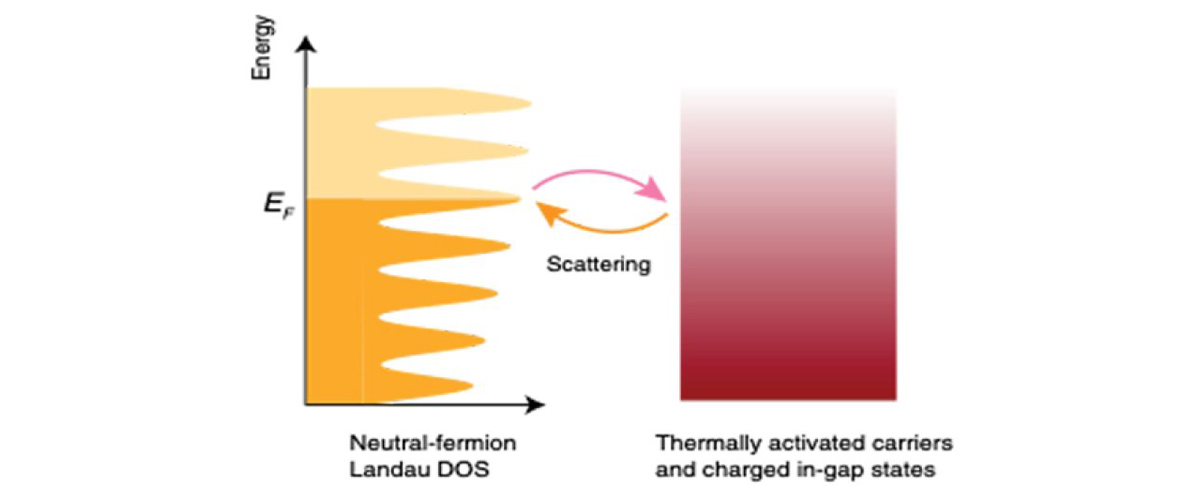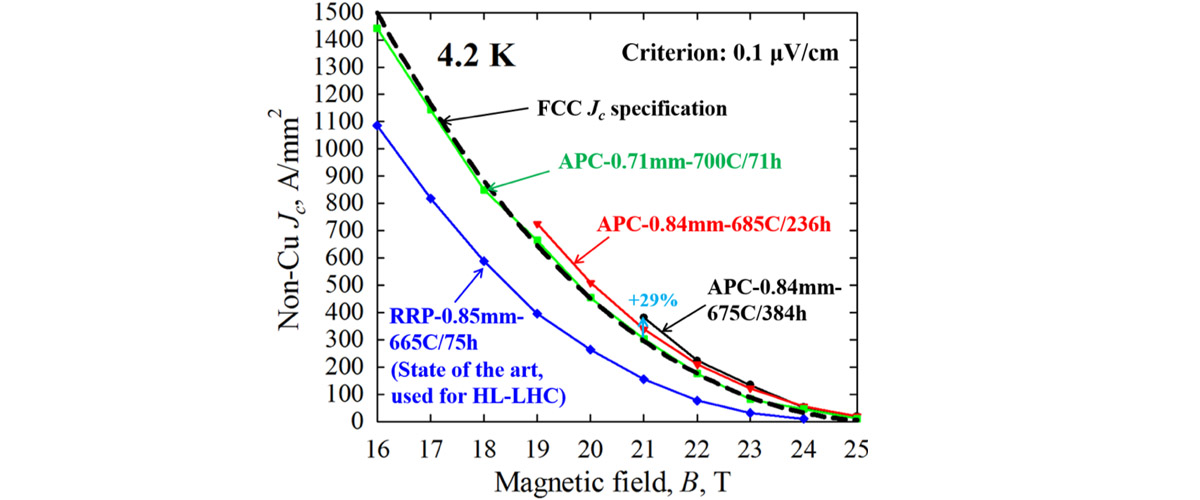A showcase of the most promising and cutting-edge research underway at the DC Field Facility.

December 19, 2025
We discovered strong evidence for a brand-new kind of “electron-like” particle in an electrical insulator: it behaves like an electron in motion but c…

October 14, 2025
Scientists at the National High Magnetic Field Laboratory have discovered that the kagome superconductor CsV3Sb3 hosts not one but two distinct superc…

July 17, 2025
A new technique from MagLab researchers uses a material’s natural twist in a magnetic field to quickly measure its performance, paving the way for nex…

March 10, 2025
Our ability to observe new physics sometimes depends on the thinnest of margins and in the case of MagLab users from McGill University, that margin is…

January 14, 2025
In the zoo of emerging quasiparticles in condensed matter physics, semi-Dirac fermions stand out as being massive and massless depending on the direct…

December 12, 2024
The physical properties of any solid material are determined by what happens in the quantum realm. How the electrons interact with each other, their s…

September 12, 2024
Since the observation of Hofstadter’s Butterfly in graphene, scientists have been working on a veritable zoo of materials which can be exfoliated down…

June 20, 2024
Topological materials are fascinating because they take the weirdness of quantum mechanics and turn it up a few notches to 11. The behavior of Samariu…

April 17, 2024
At ultra-low temperatures in the 32T all superconducting magnet, MagLab users fully mapped out the Fermi surface of UTe2, learning more about how elec…

January 23, 2024
This work demonstrates how heat is transmitted through elemental indium using thermal impedance spectroscopy. Spanning 5 orders of magnitude in freque…

November 16, 2023
Research on a tungsten disulfide material (1T’-WS2) reveals a superconducting state that is able to carry an incredibly large amount of current within…

September 11, 2023
Kagome is the name given to the traditional Japanese star-like pattern to form baskets. The same geometric pattern can be found in the crystal structu…

September 11, 2023
A specialized cybersecurity approach was developed to meet the needs of a user research facility.

July 14, 2023

April 24, 2023
Probing one of the prominent classes of atomically-thin materials, the transition metal dichalcogenides, researchers found that while dark excitons ar…

January 23, 2023
Using high magnetic fields and low temperatures, scientists were able to observe a complex set of quantum fluctuations in a Barium, Cobalt, Antimony a…

October 18, 2022
In high-temperature superconductors, a region exists between the superconducting and normal states known as the pseudogap state. Using the 45T hybrid …

July 18, 2022
Three complementary measurements in intense magnetic fields shed light on a very unusual material that behaves like a metal, but does not conduct elec…

March 11, 2022
Theory predicted that the transition between the superconducting and superfluid regimes should be continuous for electrons and holes in solid material…

January 25, 2022
Using X-ray diffraction, scientists can now detect atoms themselves moving further apart or closer together in high magnetic fields, giving science a …

November 22, 2021
Gallium nitride (GaN) and Niobium nitride (NbN) are widely used in today's technologies: GaN is used to make blue LEDs and high-frequency transistors …

September 22, 2021
Electrons in metals behave like chaotic bumper cars, crashing into each other at every opportunity. While they may be reckless drivers, this result de…

August 20, 2021
The MagLab's 32 T all-superconducting magnet is now serving users at full field. An early experiment in the magnet identified an important milestone o…

May 28, 2021
A pane of window glass and a piece of quartz are both are transparent to light, but their atomic structure is very different. Quartz is crystalline at…

March 26, 2021
Researchers based at four-year colleges and universities outside of the Research-1 (R1) tier face more obstacles to performing research than their col…
![(Left) 125Te spectral line and effective gamma with respect to magnetic field. Black circles are from the 36T Series Connected Hybrid while the pink diamonds are from the new HTS 32T magnet. (Right) Phase diagram for H//c highlighting the possible spin-nematic state. [PRB 94 064403 2016] Solid circles are from magnetostriction. Open circles from magnetostriction and thermal expansion. Open triangles from magnetization.](/media/z0nigcdk/jan2021_dc_field_probing_spin_nematic_state.jpg)
January 19, 2021
Nuclear magnetic resonance measurements were performed in the all-new 32 T superconducting magnet in an effort to confirm a new quantum state. Results…

December 29, 2020
Using electric fields as a switch to control the magnetism of a material is one of the goals behind the study of multiferroics. This work explores the…

October 06, 2020
Topology, screws, spin and hedgehogs are words not normally found in the same scientific article but with the discovery of Weyl fermions in thin tellu…

September 01, 2020
This research clarifies fundamental relationships between magnetism, superconductivity and the nature of the enigmatic “pseudogap state" in cuprate su…

July 28, 2020
Magnetic induction is used in technology to convert an applied magnetic field into an electric current and vice versa. Nature also makes extensive use…

June 01, 2020
Materials with magnetoelectric coupling - a combination of magnetic and electric properties - have potential applications in low-power magnetic sensin…

March 23, 2020
Topological semimetals are an exciting new area of research due to their number of predicted and unexpected quantum mechanical states. Understanding t…

January 23, 2020
A nematic phase is where the molecular/atomic dynamics show elements of both liquids and solids, like in liquid crystal displays on digital watches or…

October 28, 2019
Research on doped SrCu2(BO3)2 shows anomalies in the magnetization.

October 28, 2019
Studies of uranium ditelluride in high magnetic fields show superconductivity switching off at 35 T, but reoccurring at higher magnetic fields between…

September 20, 2019
In Sr3NiIrO6 vibrations in the crystal lattice (phonons) play an important role in its intriguing magnetic properties that result in a very high coerc…

June 20, 2019
MagLab users have modified the critical current of Nb3SN, a material that was thought to be fully exploited, and boosted its performance by 50%.

May 15, 2019
The observation of topological states coupled with superconductivity represents an opportunity for scientists to manipulate nontrivial superconducting…

January 29, 2019
Scientists revealed previously unobserved and unexpected FQH states in monolayer graphene that raise new questions regarding the interaction between e…

November 20, 2018
Scientists have long pursued the goal of superconductivity at room temperature. This work opens a route towards one day stabilizing superconductivity …

November 05, 2018
Scientists found that the emergence of an exotic quantum mechanical phase in Ce1-xNdxCoIn5 is due to a shape change in the Fermi surface. This finding…

July 10, 2018
This work provides important insight into one of the parent materials of iron-based superconductors.

June 27, 2018
Recent measurements of superconducting tapes in the MagLab's 45-tesla hybrid magnet shows that the power function dependence of current on magnetic fi…

March 19, 2018
In the 14 years since its discovery, graphene has amazed scientists around the world with both the ground-breaking physics and technological potential…

January 31, 2018
Decades ago, a mechanism was proposed that described a quantum phase transition to an insulating ground state from a semi-metal (excitonic insulator, …